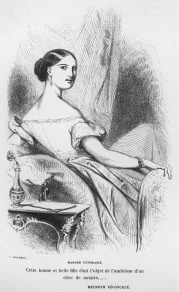
Melmoth reconciled
THE HUMAN COMEDY – Honoré de Balzac XIVth volume of works of Honoré de Balzac edited by widow André Houssiaux, publisher, Hebert and Co, successors, 7 rue Perronet – Paris (1874) Philosophical studies

Madame Euphrasie
MELMOTH RECONCILED
Dedicated work, TO GENERAL BARON DE POMMEREUL, In remembrance of the constant friendship that bound our fathers and still exists between our sons. De Balzac.
Analysis of the work This tale first appeared in June 1836 in a 6-volume collection entitled Le Livre des conteurs. When Balzac needed to integrate it into his work, he placed it in the Etudes philosophiques. This classification is quite natural, as Melmoth réconcilié is obviously a “philosophical tale”: but it is difficult to relate it to the system that Balzac claimed to set out and develop in his Etudes philosophiques. Melmoth réconcilié is, in fact, an episode added by Balzac to one of the most famous novels of the first half of the 19th century, Melmoth ou l’Homme errant, written in 1820 by the “Irish priest” Reverend Maturin and immediately translated into French with great success. The Reverend Maturin, Balzac explains, had taken up Goethe’s idea in Faust, but treated it differently. Balzac’s tale, adding a final episode to Melmoth’s adventures, is a witty critique of Maturin’s uplifting drama. If Maturin had known his time better, he would have understood that in an age that believes only in fortune and success, Melmoth would have no trouble finding a candidate for the blissful state of billionaire, the only bliss the century understands. Balzac’s boulevardière mockery does nothing to change the terms of the problem. This is what makes his tale so interesting and philosophical. He depicts the vanity of human grandeur as forcefully as Maturin. His Melmoth, capable of anything, now aspires only to the one good that is forbidden to him, love of creation and trust in God and in the promise he has made to mankind: in a word, the peace of heart that pleasures and greatness do not give. Melmoth’s inner drama, summed up in a few pages, is the best part of the tale: although it’s not clear that Balzac is as convinced as Melmoth of the vanity of success and wealth. Apart from these solid reflections from an apostle who doesn’t preach by example, Balzac’s tale is not significantly superior to the fantastic tales imagined by his contemporaries. We don’t believe in the plight of the indelicate cashier, whom Balzac presents to Melmoth as easy prey. Nor do we believe, and even less, in the phantasmagoria with which Melmoth frightens him to show him the trials that await him if he refuses to accept the exchange he proposes. This palace of mirages is no more than a piece of optical machinery that has nothing in common with Balzac’s thesis on the power of the imagination. This phantasmagoria ends in vaudeville. The cashier is rid of the great love to which he sacrificed his tranquility and his future in the classic Boubouroche scene: he finds a handsome sergeant hidden in a wardrobe. The denouement of the tale, always faithful to the easygoing procedures of Boulevard comedies, nevertheless contains a lesson. The cashier, holder of the pact, is delighted, then tires of it too, and offers it on the stock exchange to a banker in bankruptcy, who accepts it and in turn disposes of it to a bankrupt entrepreneur. This final buffoonery teaches the reader that the fear of hell is so priceless in an age of unbelief that it has become just another value to be weighed, examined and subjected to depreciation or appreciation like any other, depending on mores and generations. It’s just a journalist’s joke. But it’s bitter and fair enough. Melmoth has reconciled himself with men because they no longer believe in anything: there’s no need to persecute them to get them to agree to a pact with the devil, it’s a transaction they make every day. 
The story Melmoth has made a pact with the devil to live a hundred and fifty years, and has the power to make all his wishes come true. Soon, this omnipotence leads to a disgust with the pleasures and grandeur of men, and he longs to break the contract that has brought him nothing but illusory goods. He can if he manages to find a “replacement” to take over the contract in his name. He then uses his power to place men in a desperate situation, offering to save them by taking their place. He has the misfortune to meet only good Christians who prefer their eternal salvation to the power of their tempter. Each of his attempts is an episode in the novel.
Story and preface from the 23rd volume of La Comédie Humaine published by France Loisirs in 1987, based on the full text published under the auspices of the Société des Amis d’Honoré de Balzac, 45, rue de l’Abbé-Grégoire – 75006 Paris.

Melmoth
Paris, May 6, 1835
The characters Melmoth: John Melmoth, Englishman, died 1822. Euphrasie: Prostitute
Character genealogy source: Félicien Marceau “Balzac et son monde” Gallimard.
No Comments